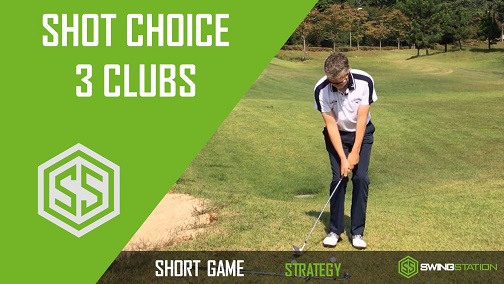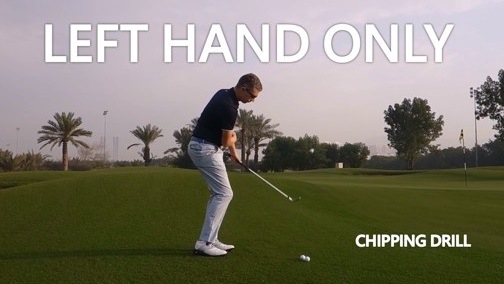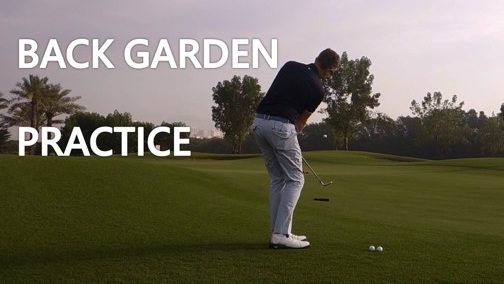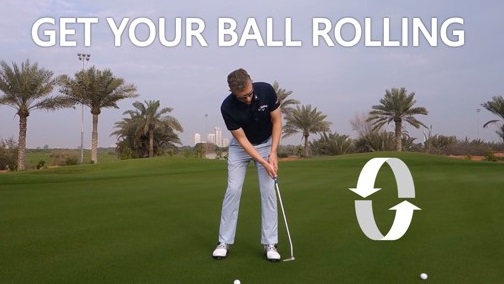Selecting the Correct Shot Around the Green
Choosing the Correct Shot Will Help Lower Your Scores
Hi Robin here. Now, when I am playing with my students, even some of the better players or playing Pro-Ams, one thing I noticed is people waste a lot of shots by not choosing the correct shot around the green. They choose a more difficult shot than what they really need to play.
So, how do you choose the right club? How do you choose the right shot when you’ve missed the green? Well, think about it like this. If I had three balls and I was going to throw these to the pin. One option, I threw it low, keeping it close to the ground. Medium flight – a little bit higher, or I threw it really up in the air.
Which of those is the most easy option to get the ball close to the pin? It’s obvious. It’s the lower one. Now, this doesn’t mean that with a little bit of practice I can’t toss the ball up in the air a lot and get it close to the pin. I can, but not with much consistency. I couldn’t repeat it time after time. And that’s the same in and around the green. I see players choosing a more high shot than what they need. Sometimes it looks great. They pitch it up beside the hole. It stops, a little bit of spin. It looks fantastic, but they can’t repeat it time after time. They’re making simple bogeys from around the edge of the green.
So, the goal here is, when you’ve missed the green, is to choose the most simple shot that you’ve got available to you. That normally means keeping the ball as low to the ground as you can.
So, let’s go through this – these four situations, four balls laid out. This first one, I’m right up close to the edge of the green. I’ve got quite a lot of the green to work with relative to how far I am away from the edge of the green. So, I’m going to choose my landing area, just a little bit on the green, about a meter on the green. Why I choose that and not around the edge is… I don’t like to see people choosing the edge of the green as a landing area. It doesn’t give you much margin for error.
Let’s say you miss your landing area by just a matter of inches. You hit the fringe. The ball sticks. The ball could finish three, four meters away from the pin, even though when in your execution of the shot, you only missed it by a few inches. Or perhaps you’re trying to land it in the edge of the green, and you hit the green. You’ve got a ball flight for the fringe to kill a little bit, but landing on the green, the ball lands on three or four meters past the hole. Again, you haven’t played a bad shot, but the result is leaving you a very difficult par putt.
So, always try to get it a little bit more on the green. If you’re going to try to land it on the green, get it on the green – a meter, meter and a half. If you’re going to try and land it on the edge, land it well short of the edge – a meter, meter and a half, again. Again, it gives you a little bit more margin for error.
So this shot, I like to change my club. I know some of my players will keep the same club just learning to deloft or increase the loft, but I’ve switched my mine to a nine iron. And for me this is almost a makeable chance here. Actually, I missed my landing area a little bit, a little bit short, but I had some margin for error, so it still hit the green. Okay, I made my par. If I had hit my landing area, it might have went in.
So, moving on to shot number two. Obviously, I don’t have quite as much, it’s about a 50-50 shot, this here. I don’t have quite as much green to work with relative to the fairway I need to carry. So I’m going to switch club, give myself a little bit of a higher ball flight. Same landing area, but it’s still the most simple shot that I have available to me.
Okay, there’s two pars. Again, I made that shot look simple. Actually, my contact wasn’t perfect. Again, I missed my landing area slightly, but the result was good.
Moving on to shot number three. Again, we’re moving further away from the green. Now, I’ve got a 75% – 25%. I am going to need a higher, if I was to throw the ball, I would definitely need a higher ball flight. The shot level, the difficulty of this shot is increasing, but I’m still going to choose the most simple shot I’ve got available to you.
You might be asking me, “Well why would you land it short?” It depends on what kind of golf course you’re playing on. Here this grass is a little bit wirey. When I land it short of the green, the bounce is very unpredictable. But if you’re playing a links course, sure, your most simple shot might be still low, short of the green, letting it run up. Even getting your putter out.
So, just a regular 58 degree wedge, for me, should allow me to land the ball on the green, and just let it stop beside the hole.
Okay, good result. A reasonably difficult shot, but I think I made it, again, look quite simple.
So, moving on to the last shot. Missed the green by quite a lot. Now, the easiest shot I’ve got available to me is quite a high one. Even though it’s a difficult shot, it’s still the most simple shot I’ve got available to me. The percentage of up and down here is definitely going to reduce a little bit, just due to the difficulty. But for this shot, my regular loft of my sand wedge is not really going to work. I’m going to need a higher ball flight. I am going to open up the club face a little bit, play more of a mini lob shot.
All right, so, yeah I played this better than I expected. The last one was a more difficult shot, but it was still the most simple shot I’ve got available to me.
So, next time you’re practicing or playing, try to start thinking a little more about what shot you’re selecting. Is it the most simple shot? And the golden rule is to keep the ball as low as you possibly can.




